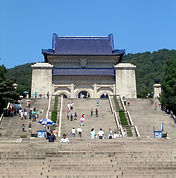
MY Favourite Places to Visit




Presidential Palace of Nanjing (總統府舊址)
September 2016
This place to me, is a must go place in Nanjing. This Presidential Palace comprises of historical footprints across 3 controversial periods in the history of China - the late Ching Dynasty, the Taiping Revolution era, as well as the residence and office of Dr Sun Yut-sen.
The site is well preserved and a lot of the rooms and palaces have turned into information sites with content-rich documentaries and photos. I can easily spent a day in this Palace.
Nanjing Massacre Memorial Hall (侵華日軍南京大屠殺遇難同胞紀念館)
September 2016
The Nanjing Massacre Memorial Hall is a hall to memorialise those that were killed in the Nanjing Massacre by the Imperial Japanese Army in and around the then capital of China, Nanjing, after it fell on December 13, 1937. It is located in the southwestern corner of Nanjing known as Jiangdongmen, near a site where thousands of bodies were buried, called a "pit of ten thousand corpses".
This is also a must-go place in Nanjing if you are interested to understand what actually happened to the people of Nanjing during the Japanese occupied era. This is a rich collection of the real incidents that have actually occurred and encounters by lucky survivors from that era.
 |
|---|
 |
 |
 |
 |

Sun Yat-sen Mausoleum (中山陵)
September 2016
Dr. Sun Yat-sen's Mausoleum is situated at the foot of the second peak of Mount Zijin (Purple Mountain) in Nanjing, China.
There is a tri-arched marble gate is inscribed with the personal motto of Dr. Sun, with four Chinese characters written by him, "Tian Xia Wei Gong" ("天下為公") which means "What is under heaven is for all". A bit of walk if you decide to take a look at this Mausoleum but the scenery is beautiful. To me, worth the walk.
Xuanwu lake (玄武湖)
September 2016
A visit to the lake and its park can include up to a five-hour walk. Within the park are temples, pagodas, pavilions, gardens, teahouses, restaurants, entertainment venues, a small zoo, and other attractions. Its main entrance is the Xuanwu Gate.
Xuanwu Lake Park (玄武湖公園), once an imperial lake garden, is now a city park. In the spring, the pink cherry blossom trees are in bloom. Summer visitors experience emerald lotus leaves, flowers, and "a peaceful haven of weeping willows" followed by red maples and golden ginkgos in the fall.
 |
|---|
 |
 |
 |




Zhan Garden (瞻園)
September 2016
The first garden on this site was built during the early Ming dynasty by the general Xu Da. It was destroyed during the Taiping Rebellion in the Qing dynasty, but was rebuilt later. As the main residence of Kiangsu Provincial Governor in the late Qing dynasty, it was visited by the Qianlong Emperor and was restored after 1949, with the southern 'mountain' added in 1960. On the grounds is the Taiping Heavenly Kingdom History Museum.
This is awarded as the Number 1 Garden of Nanjing. Beautiful Garden. If you love to take photos, this is a very good place to visit.
Gate of China (中華門)
September 2016
The Gate of China is a gate and defensive complex on the city wall of Nanjing, China. It is the southern gate of Nanjing city. It was built on the site of the south gate of the capital city of the Southern Tang dynasty. It was the largest among the thirteen gates of Nanjing.
Standing on the top of the Gate looking across Nanjing is a nice view. There are also different doors and rooms inside the Gate where historical information about the Gates have been displayed. An additional activity of archery is also available for tourists.
 |
|---|
 |
 |
 |
 |
 |



